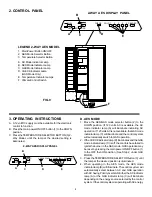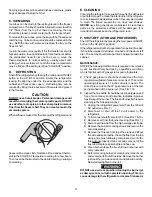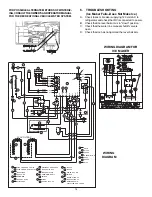
10
from drying out, keep it in covered dishes, containers, plastic
bags or wrapped in aluminum foil.
C. ICE MAKING
Ice cubes can be made in the ice tray placed in the freezer
compartment. The tray should be filled with water to within
1/4" (5mm) from the top. For faster ice making, the tray
should be placed in direct contact with the freezer shelf.
To release the ice cubes, seize the tray with both hands and
twist the tray. Cubes not required should be replaced in the
tray. Refill the tray with water and replace the tray on the
freezer shelf.
Ice will be made more rapidly if the thermostat is set at its
highest position. It is a good idea to do this a few hours before
the anticipated need for ice, but be sure to move the
thermostat back to normal setting, usually about mid-
setting, when ice is formed. Food in the lower compartment
may be frozen if the setting is left on "COLDEST" position.
D.
DEFROSTING
Shut off the refrigerator by pressing the main power ON/OFF
button to the UP (OFF) position. Empty the refrigerator,
leaving the drip tray under the finned evaporator, and the
cabinet and freezer door open. Defrosting time can be
reduced by filling the ice bucket with hot water and place it
in the freezer.
CAUTION
DO NOT use a hot air blower. Permanent damage could
result from warping the metal or plastic parts. DO NOT
use a knife or an ice pick, or other sharp tools to remove
frost from the freezer shelf. They can create a leak in the
ammonia system.
When all frost is melted, dry the interior of the refrigerator and
freezer with a clean cloth. Replace all food and set thermo-
stat to the COLDEST temperature setting for a few hours.
Then reset the thermostat to the desired setting, usually at
mid-setting.
E. CLEANING
Cleaning the refrigerator is usually done after it is defrosted
or put into storage. To clean the interior liner of the refrigera-
tor, use lukewarm weak soda solution. Use only warm water
to clean the finned evaporator, ice trays and shelves.
NEVER use strong chemicals or abrasives to clean these
parts as the protective surfaces will be damaged. It is
important to always keep the refrigerator clean.
F. SHUT-OFF (STORAGE PROCEDURE)
Shut off the refrigerator by pressing the main power ON/OFF
button to the UP (OFF) position.
If the refrigerator will not be in operation for a period of weeks,
it should be emptied, defrosted, cleaned and the doors left
ajar. The ice tray should also be dried and kept outside the
cabinet.
MAINTENANCE:
NOTE: The following maintenance is required once or twice
a year, but should only be done by a qualified serviceman
who is familiar with LP gas systems and refrigerators.
A. The LP gas pressure should be checked and the main
regulator readjusted if pressure is incorrect. The correct
operating pressure is 11 inches of water column. The
correct place to take the LP gas pressure is at the test
port just ahead of the burner jet. (See FIG. 10).
B. Inspect the flue baffle. It should be reasonably clean and
free of soot. Heavy soot formation indicates improper
functioning of the burner. The flue and burner both require
cleaning in the following manner:
1) Unplug the refrigerator power cord from the 120 volt
AC outlet (see FIG. 7).
2) Disconnect or shut off the 12 volt power to the
refrigerator.
3) Turn manual shutoff valve to OFF. (See FIG. 7 & 10).
4) Remove cover from the burner housing. (See FIG . 7).
5) Disconnect the wire from the high voltage electrode.
6) Remove the burner mounting screws and remove the
burner assembly.
7) Remove the flue cap from top of flue tube and lift out
the wire and spiral baffle. Clean the flue from the top
using a flue brush. Blowing compressed air into the
flue will not properly clean soot and scale out of the
flue tube. Replace spiral baffle and flue cap.
8) Clean burner tube with a brush. Blow out burner with
compressed air.
9) Before removing burner jet, clean burner area of soot
and scale that fell out of flue tube. Remove the burner
jet. Soak the jet in wood alcohol and allow it to air dry.
Reinstall and tighten burner jet.
DO NOT use a wire or pin when cleaning the burner jet
as damage can occur to the precision opening. This can
cause damage to the refrigerator or create a fire hazard.
































